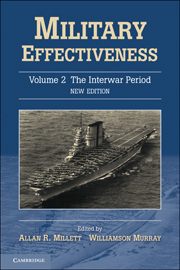Book contents
- Frontmatter
- Contents
- List of Contributors
- Introduction: Military Effectiveness Twenty Years After
- Maps
- 1 The Soviet Armed Forces in the Interwar Period
- 2 The French Armed Forces, 1918–40
- 3 The Military Effectiveness of the US Armed Forces, 1919–39
- 4 The British Armed Forces, 1918–39
- 5 Japanese Military Effectiveness: The Interwar Period
- 6 The Italian Armed Forces, 1918–40
- 7 German Military Effectiveness between 1919 and 1939
- 8 Military Effectiveness of Armed Forces in the Interwar Period, 1919–41: A Review
- Index
2 - The French Armed Forces, 1918–40
Published online by Cambridge University Press: 05 June 2012
- Frontmatter
- Contents
- List of Contributors
- Introduction: Military Effectiveness Twenty Years After
- Maps
- 1 The Soviet Armed Forces in the Interwar Period
- 2 The French Armed Forces, 1918–40
- 3 The Military Effectiveness of the US Armed Forces, 1919–39
- 4 The British Armed Forces, 1918–39
- 5 Japanese Military Effectiveness: The Interwar Period
- 6 The Italian Armed Forces, 1918–40
- 7 German Military Effectiveness between 1919 and 1939
- 8 Military Effectiveness of Armed Forces in the Interwar Period, 1919–41: A Review
- Index
Summary
Introduction
The swift collapse of France in May–June 1940 came as a rude shock to the European military establishment and experienced military observers. French military forces had played a crucial role in the defeat of Germany in 1914–18, and following the armistice they retained a reputation for being a fairly efficient and very effective force. By the usual criteria – relatively modern weaponry, large size, ample logistical support, and sound leadership – the French military seemed to be capable of ensuring France's safety and eventually winning, when supported by its allies, the long total war foreseen by political and military leaders.
Even those who criticized the French military effort and who called for reforms, such as Paul Reynaud,did not doubt the widely publicized slogan of 1939–40: ‘We shall win because we are stronger.’ The British, who were included within the ‘we’ opposing the Germans, also had a favorable view of the French military. In 1938 Winston Churchill described the French Army as ‘the most perfectly trained and faithful mobile force in Europe.’ General Sir Edmund Ironside, the British Chief of the Imperial General Staff from September 4, 1939, until May 27, 1940, acknowledged his confidence in the French and saw nothing significantly amiss in the French Army, even though he saw major weaknesses in their air force. Apparently, only the Germans had serious doubts before May–June 1940 about the military effectiveness of the French, but they too did not dismiss them as being unprepared.
- Type
- Chapter
- Information
- Military Effectiveness , pp. 39 - 69Publisher: Cambridge University PressPrint publication year: 2010
- 1
- Cited by



